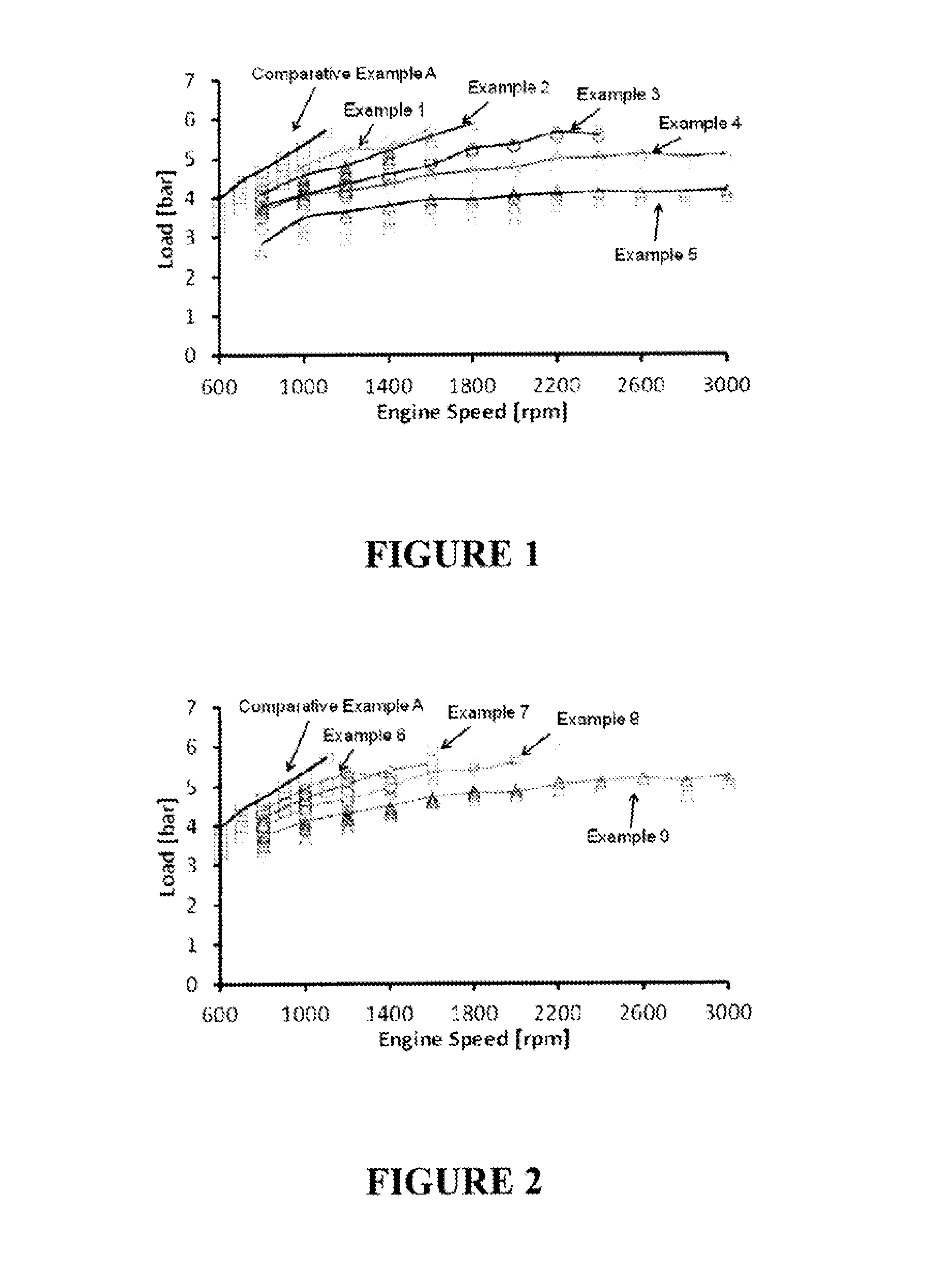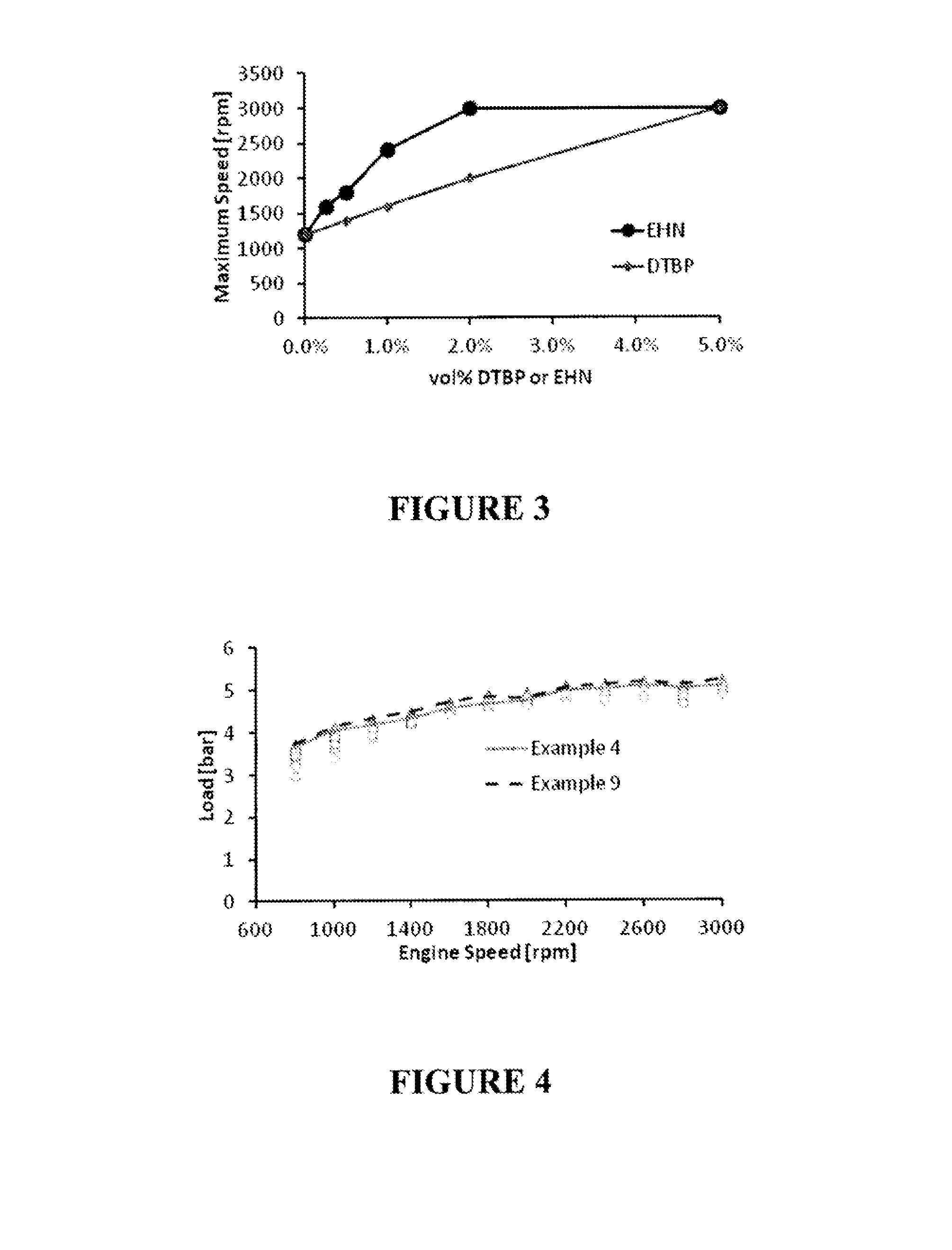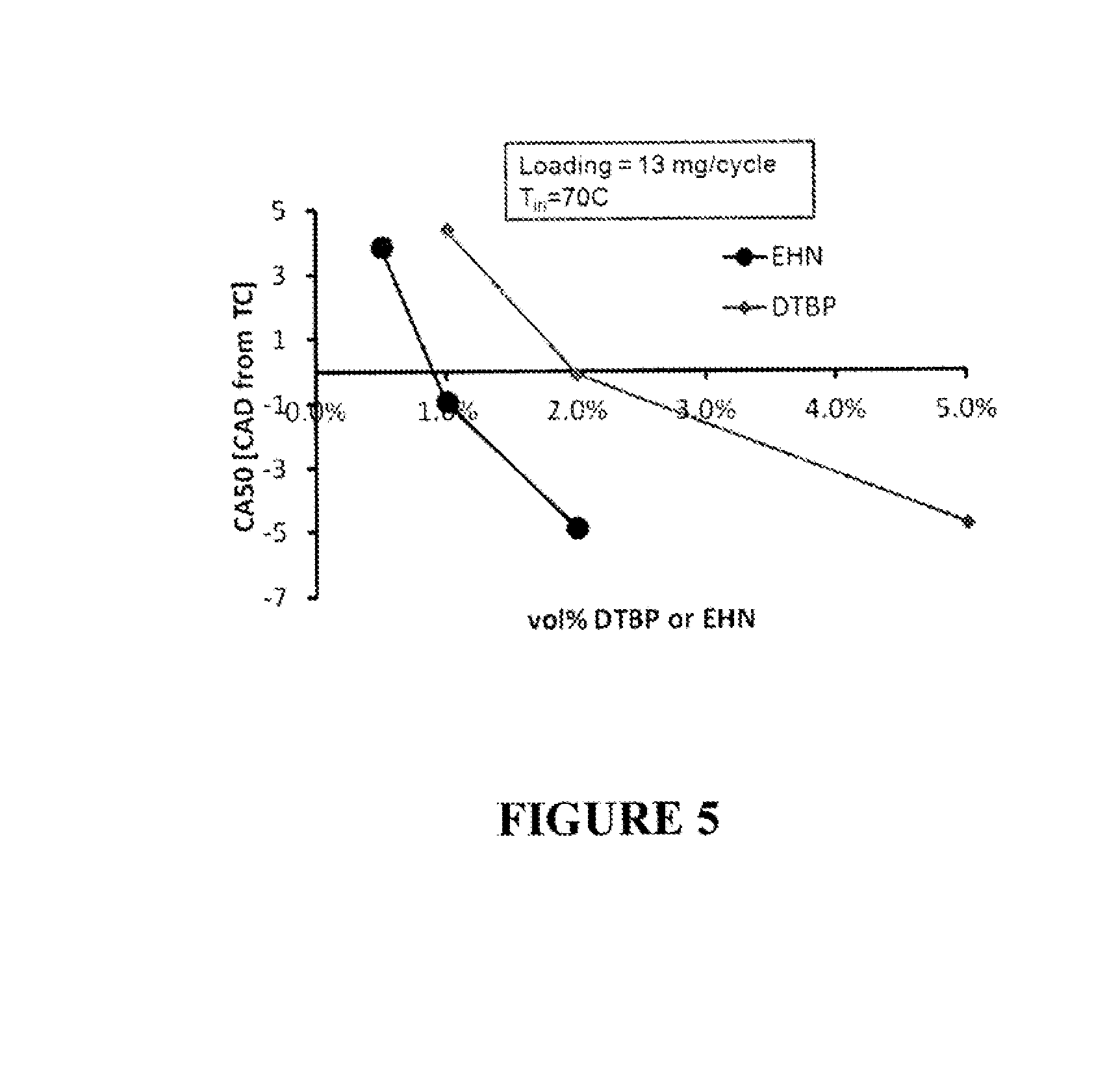Method for increasing the maximum operating speed of an internal combustion engine operated in a low temperature combustion mode
a technology of internal combustion engine and maximum operating speed, which is applied in the direction of machines/engines, mechanical equipment, electric control, etc., can solve the problems of reducing the maximum operating speed of the internal combustion engine, so as to increase the maximum operating speed and increase the engine power output. , the effect of increasing the maximum operating speed
Active Publication Date: 2014-11-13
CHEVROU USA INC
View PDF16 Cites 0 Cited by
- Summary
- Abstract
- Description
- Claims
- Application Information
AI Technical Summary
Benefits of technology
The patent text describes a method for increasing the maximum operating speed of internal combustion engines that use gasoline with a high octane rating. This is achieved by adding one or more compounds called cetane improvers to the fuel composition. The use of these additives reduces the time required for the fuel to ignite under compression ignition conditions, resulting in a faster-moving engine. The method can be applied to engines operating in low temperature combustion modes, premixed compression ignition combustion modes, or homogeneous charge compression ignition modes, and can increase power output and drivability while reducing the complexity of the transmission.
Problems solved by technology
In general, gasoline engines coupled with 3-way emissions catalysts produce fewer emissions but are less efficient, while, in general, diesel engines are more efficient but produce more emissions.
However, these systems are costly, add to the weight of the vehicle, and minimize fuel economy due to the added weight, increase in exhaust back pressure, and the need to use fuel to regenerate the systems.
This does greatly reduces the effectiveness of a spark plug.
The use of fuels with gasoline-type volatilities (vs. heavier fuels such as diesel), combined with premixing the fuel and air, limit soot production.
One drawback to these LTC-type technologies is that the speed-load (power output) operating range is very limited, and significantly smaller than required and provided for by current gasoline spark-ignited and diesel compression ignition internal combustion engines.
One reason the speed-load range is limited with LTCengines is that it is difficult to control the ignition timing.
Accordingly, as the speed increases in advanced combustion engines, the possibility that the fuel will not ignite (misfire) increases, and the engine becomes unstable (a higher combustion variance).
A significant drawback of the use of fuels such as naphthas having lower octane than pump gasoline is that they are present in refineries in much smaller quantities than gasoline and availability for sale at fuel stations would require additional fuel storage tanks which most fuel stations do not have space for.
However, due to the higher RON of conventional pump gasoline, the speed range may be affected.
It generally takes a longer time to compression ignite higher RON fuels, which can become an issue at higher speeds.
However, the use of cetane improvers in conventional pump gasolines is limited, particularly in LTC processes.
However, gasoline is known to be a more complex mixture and does not always perform the same as PRF.
Further, they state that “adding an ignition promoter to extend the lower fueling rate limit” (i.e. the low load limit) “will result in a corresponding decrease in the maximum fueling level” (i.e. the high load limit).
Heretofore, there has been no appreciation or recognition that the addition of one or more cetane improvers to conventional pump gasoline can increase or expand the engines range of operating speeds and thus improve its performance and feasibility for use in advanced combustion engines.
Method used
the structure of the environmentally friendly knitted fabric provided by the present invention; figure 2 Flow chart of the yarn wrapping machine for environmentally friendly knitted fabrics and storage devices; image 3 Is the parameter map of the yarn covering machine
View moreImage
Smart Image Click on the blue labels to locate them in the text.
Smart ImageViewing Examples
Examples
Experimental program
Comparison scheme
Effect test
example 1
[0046]To the pump gasoline of Comparative Example A was added 0.25 wt. % of 2-ethyhexyl nitrate (EHN).
example 2
[0047]To the pump gasoline of Comparative Example A was added 0.50 wt. % of EHN.
example 3
[0048]To the pump gasoline of Comparative Example A was added 1 wt. % of EHN.
the structure of the environmentally friendly knitted fabric provided by the present invention; figure 2 Flow chart of the yarn wrapping machine for environmentally friendly knitted fabrics and storage devices; image 3 Is the parameter map of the yarn covering machine
Login to View More PUM
| Property | Measurement | Unit |
|---|---|---|
| RON | aaaaa | aaaaa |
| RON | aaaaa | aaaaa |
| wt. % | aaaaa | aaaaa |
Login to View More
Abstract
Disclosed herein is a method for increasing the maximum operating speed of an internal combustion engine operated in a low temperature combustion ignition mode, the method comprising operating the engine with a fuel composition comprising (a) gasoline having a Research Octane Number (RON) greater than 85 and (b) one or more cetane improvers.
Description
BACKGROUND OF THE INVENTION[0001]1. Technical Field[0002]The present invention is directed to a method for increasing the maximum operating speed of an internal combustion engine operated in a low temperature combustion mode such as a homogeneous charge compression ignition mode.[0003]2. Description of the Related Art[0004]Internal combustion engines, including diesel engines, gasoline engines, gaseous fuel-powered engines, and other engines known in the art exhaust a complex mixture of air pollutants. Internal combustion engines, especially automotive internal combustion engines, generally fall into one of two categories, spark ignition engines and compression ignition engines. Traditional spark ignition engines, such as gasoline engines, typically function by introducing a fuel / air mixture into the combustion cylinders, which is then compressed in the compression stroke and ignited by a spark plug. Traditional compression ignition engines, such as diesel engines, typically functio...
Claims
the structure of the environmentally friendly knitted fabric provided by the present invention; figure 2 Flow chart of the yarn wrapping machine for environmentally friendly knitted fabrics and storage devices; image 3 Is the parameter map of the yarn covering machine
Login to View More Application Information
Patent Timeline
 Login to View More
Login to View More Patent Type & Authority Applications(United States)
IPC IPC(8): C10L10/12
CPCC10L10/12C10L1/10C10L1/1811C10L1/23C10L2270/023F01B1/12F02D19/084F02D41/0025F02D41/3035Y02T10/12Y02T10/30
Inventor CANNELLA, WILLIAM JAMESMARIA, AMIR GAMAL
Owner CHEVROU USA INC
Features
- R&D
- Intellectual Property
- Life Sciences
- Materials
- Tech Scout
Why Patsnap Eureka
- Unparalleled Data Quality
- Higher Quality Content
- 60% Fewer Hallucinations
Social media
Patsnap Eureka Blog
Learn More Browse by: Latest US Patents, China's latest patents, Technical Efficacy Thesaurus, Application Domain, Technology Topic, Popular Technical Reports.
© 2025 PatSnap. All rights reserved.Legal|Privacy policy|Modern Slavery Act Transparency Statement|Sitemap|About US| Contact US: help@patsnap.com



